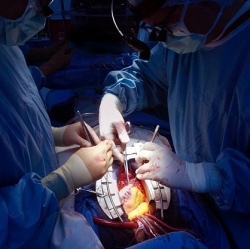
Hard objects can be are created using 3D printers by placing using thin layers of a material such as plastic or metal, slowly constructing the object. For several years, doctors have made hard medical implants using the printers, but soft tissues such as organs are more difficult because the materials used for them can’t support their own weight.
Researchers at Carnegie Mellon University may have solved the problem, however, by devising a method of 3-D printing soft objects by layering the materials they’re made with inside of another specially designed type of gel.
Adam Feinberg, an associate professor of materials science and engineering at Carnegie Mellon, said the research has been made somewhat easier because the research team used off-the-shelf 3-D printers and open source software to augment the software that operates them.
"The challenge with soft materials, think about something like Jello that we eat, is that they collapse under their own weight when 3D printed in air," Adam Feinberg, lead author of the study, said in a press release. "So we developed a method of printing these soft materials inside a support bath material. Essentially, we print one gel inside of another gel, which allows us to accurately position the soft material as it’s being printed, layer-by-layer."
The researchers developed a printing method called FRESH, or "Freeform Reversible Embedding of Suspended Hydrogels," that starts with an appropriate-sized container of support gel. The printer, armed with a needle, injects other gels into the support gel based on computer-aided design models.
Once the structure is completed, the support gel is melted, leaving only the soft object that had been printed. In tests, the researchers created femurs, branched coronary arteries, trabeculated embryonic hearts, and human brains using the method.
Feinberg said his research team has had some focus on the heart, as they have constructed a properly designed organ and now are researching ways to inject living cardiac cells into the 3D-printed heart, providing a scaffold to grow a heart in the lab.
"Not only is the cost low, but by using open-source software, we have access to fine-tune the print parameters, optimize what we’re doing and maximize the quality of what we’re printing," Feinberg said. "It has really enabled us to accelerate development of new materials and innovate in this space. And we are also contributing back by releasing our 3-D printer designs under an open-source license."
